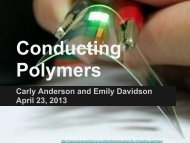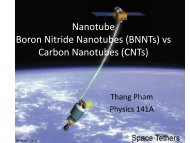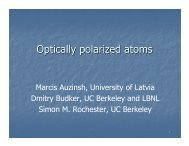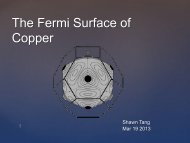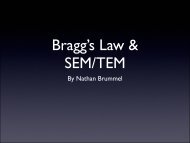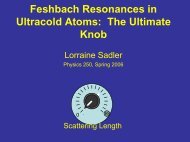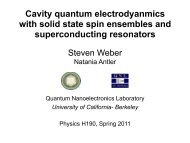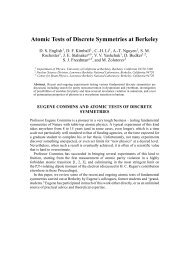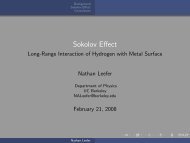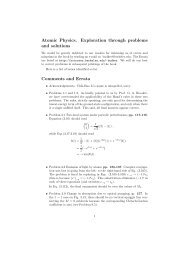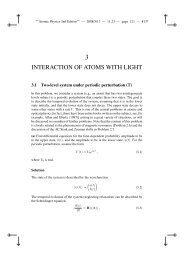Resonant nonlinear magneto-optical effects in atomsâ - The Budker ...
Resonant nonlinear magneto-optical effects in atomsâ - The Budker ...
Resonant nonlinear magneto-optical effects in atomsâ - The Budker ...
Create successful ePaper yourself
Turn your PDF publications into a flip-book with our unique Google optimized e-Paper software.
3<br />
@Ω <br />
Σ Σ <br />
n<br />
n <br />
n <br />
gΜB<br />
@<br />
M = −1 M = 0 M = +1<br />
gΜB<br />
FIG. 2 An F = 1 → F ′ = 0 atomic transition. In the presence<br />
of a longitud<strong>in</strong>al magnetic field, the Zeeman sublevels<br />
of the ground state are shifted <strong>in</strong> energy by gµBM. This<br />
leads to a difference <strong>in</strong> resonance frequencies for left- (σ + )<br />
and right- (σ − ) circularly polarized light.<br />
Refractive <strong>in</strong>dex<br />
1<br />
0<br />
n n <br />
10 20 greater rotation “per atom” than heavy fl<strong>in</strong>t.<br />
In this paper, we briefly review the physics and applications<br />
of resonant l<strong>in</strong>ear <strong>magneto</strong>-<strong>optical</strong> <strong>effects</strong>, and then<br />
turn to our ma<strong>in</strong> focus—the <strong>nonl<strong>in</strong>ear</strong> <strong>effects</strong> (i.e., <strong>effects</strong><br />
<strong>in</strong> which <strong>optical</strong> properties of the medium are modified<br />
by <strong>in</strong>teraction with light). We will also discuss various<br />
applications of <strong>nonl<strong>in</strong>ear</strong> <strong>magneto</strong>-optics <strong>in</strong> atomic vapors,<br />
and the relation between <strong>nonl<strong>in</strong>ear</strong> <strong>magneto</strong>-optics<br />
and a variety of other phenomena and techniques, such<br />
as coherent population trapp<strong>in</strong>g, electromagnetically <strong>in</strong>duced<br />
transparency, <strong>nonl<strong>in</strong>ear</strong> electro-optics <strong>effects</strong>, and<br />
self-rotation.<br />
II. LINEAR MAGNETO-OPTICS<br />
In order to provide essential background for understand<strong>in</strong>g<br />
<strong>nonl<strong>in</strong>ear</strong> <strong>magneto</strong>-<strong>optical</strong> <strong>effects</strong> (NMOE), we<br />
first review l<strong>in</strong>ear <strong>magneto</strong>-optics of atoms and molecules<br />
near resonance. (See Sec. III for a discussion of the difference<br />
between the l<strong>in</strong>ear and <strong>nonl<strong>in</strong>ear</strong> <strong>magneto</strong>-<strong>optical</strong><br />
<strong>effects</strong>.)<br />
A. Mechanisms of the l<strong>in</strong>ear <strong>magneto</strong>-<strong>optical</strong> <strong>effects</strong><br />
At the conclusion of the 19th century, Macaluso and<br />
Corb<strong>in</strong>o (1898a, 1899, 1898b), study<strong>in</strong>g absorption spectra<br />
of the alkali atoms <strong>in</strong> the presence of magnetic fields,<br />
discovered that the Faraday effect (<strong>magneto</strong>-<strong>optical</strong> activity)<br />
<strong>in</strong> the vic<strong>in</strong>ity of resonance absorption l<strong>in</strong>es also<br />
has a dist<strong>in</strong>ct resonant character (see also work by Fork<br />
and Bradley III, 1964).<br />
<strong>The</strong> pr<strong>in</strong>cipal mechanism of the l<strong>in</strong>ear Macaluso-<br />
Corb<strong>in</strong>o effect can be illustrated by the case of an F =<br />
1 → F ′ = 0 transition (Fig. II.A), where F, F ′ are the<br />
total angular momenta. 2 L<strong>in</strong>early polarized light <strong>in</strong>ci-<br />
8 4 0 4 8<br />
Light detun<strong>in</strong>g (<br />
FIG. 3 <strong>The</strong> dependence of the refractive <strong>in</strong>dex on light frequency<br />
detun<strong>in</strong>g ∆ <strong>in</strong> the absence (n) and <strong>in</strong> the presence<br />
(n ± ) of a magnetic field. Shown is the case of 2gµB = ¯hΓ<br />
and a Lorentzian model for l<strong>in</strong>e broaden<strong>in</strong>g. <strong>The</strong> lower curve<br />
shows the difference of refractive <strong>in</strong>dices for the two circular<br />
polarization components. This is the characteristic spectral<br />
profile of l<strong>in</strong>ear <strong>optical</strong> rotation.<br />
dent on the sample can be decomposed <strong>in</strong>to two counterrotat<strong>in</strong>g<br />
circular components σ ± . In the absence of a<br />
magnetic field, the M = ±1 sublevels are degenerate and<br />
the <strong>optical</strong> resonance frequencies for σ + and σ − co<strong>in</strong>cide.<br />
<strong>The</strong> real part of the refractive <strong>in</strong>dex n associated with the<br />
atomic medium is shown <strong>in</strong> Fig. II.A as a function of the<br />
light frequency detun<strong>in</strong>g ∆ (the dispersion curve). <strong>The</strong><br />
refractive <strong>in</strong>dex is the same for the two circular components.<br />
When a magnetic field is applied, however, the Zeeman<br />
shifts 3 lead to a difference between the resonance frequencies<br />
for the two circular polarizations. This displaces<br />
the dispersion curves for the two polarizations as shown<br />
<strong>in</strong> Fig. II.A. A characteristic width of these dispersion<br />
curves, Γ, corresponds to the spectral width (FWHM)<br />
of an absorption l<strong>in</strong>e. Under typical experimental conditions<br />
<strong>in</strong> a vapor cell this width is dom<strong>in</strong>ated by the<br />
Doppler width and is on the order of 1 GHz for <strong>optical</strong><br />
transitions. <strong>The</strong> difference between n + and n − (Fig.<br />
II.A) signifies a difference <strong>in</strong> phase velocities of the two<br />
circular components of light and, as a result, the plane<br />
of polarization rotates through an angle<br />
ϕ = π(n + − n − ) l λ . (1)<br />
Here l is the length of the sample, and λ is the wavelength<br />
of light. In addition to the difference <strong>in</strong> refraction for the<br />
two circular polarizations (circular birefr<strong>in</strong>gence), there<br />
2 Throughout this article, we designate as F, F ′ total angular momenta<br />
of the lower and the upper states of the transition, respectively.<br />
For atoms with zero nuclear sp<strong>in</strong>, F, F ′ co<strong>in</strong>cide with the<br />
total electronic angular momenta J, J ′ .<br />
3 <strong>The</strong> connection between the Faraday and the Zeeman <strong>effects</strong> was<br />
first established by Voigt (1898b), who also expla<strong>in</strong>ed the observations<br />
of Macaluso and Corb<strong>in</strong>o (Voigt, 1898a).



